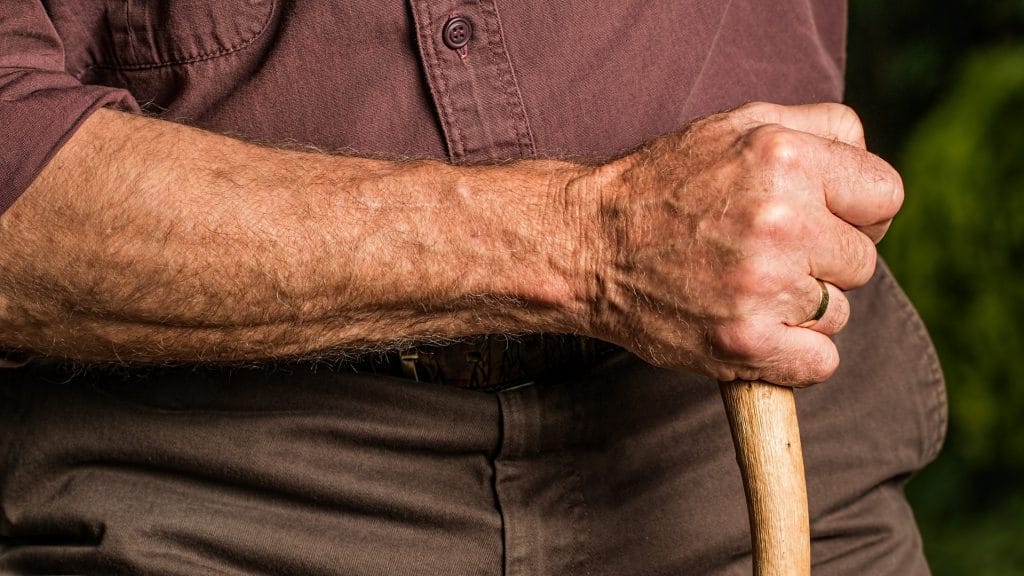The Most Important Facts About Degenerative Arthritis

Among the many types of arthritis, degenerative arthritis is the most common joint disease. Also called osteoarthritis, this condition affects millions of people worldwide. It’s a chronic inflammatory disease of one or more joints, characterized by the involvement of the articular cartilage and the underlying bone surfaces.
This condition is usually attributed to older people, perhaps because inflamed and difficult-to-move joints are a more characteristic image of old age.
Read on to discover more about this type of arthritis, its signs and symptoms, causes, how it’s diagnosed, osteoarthritis prevention, how it differs from rheumatoid arthritis, and all the treatment options.
What Is Degenerative Arthritis?
Osteoarthritis is a degenerative disease of the joints that can impact people’s health in different ways. There are two types of osteoarthritis: primary and secondary. That said, the primary is more common and involves degenerative arthritis of the spine, thumbs, fingers, and the great toes. On the other hand, the secondary occurs with a pre-existing joint abnormality, including trauma or injury.
It only causes mild symptoms (such as pain and stiffness) that appear and disappear in some cases. In contrast, others suffer from severe and permanent problems. Moreover, we can usually find osteoarthritis in the knee and fingers. However, each of your joints may be affected by this condition.
The pathophysiology of osteoarthritis involves damaged or worn-out cartilage that causes pain and stiffness in a joint or multiple joints. Therefore, osteoarthritis is sometimes called the arthritis of aging. Although linked to the aging process, this type of arthritis isn’t directly induced by it. Instead, it’s due to a decreased content in the joints of water and proteoglycans—complex molecules that give flexibility and resistance to articular cartilage.
Generally, the degenerative arthritis process can be defined as a joint wearing out or, in particular, the joint cartilage that covers the surface of the bone wearing down. At the same time, the amount of joint fluid that fills the joint gap and lubricates the surface of the cartilage decreases.
As a result, the bone movement involved in joint formation is hampered. Inflammatory arthritis is excruciating and never occurs in healthy joints. This, however, doesn’t mean that osteoarthritis affects only seniors whose joints are worn out. Although osteoarthritis occurs more often after 65, it can happen at any age, usually after 45.
Osteoarthritis is, more specifically, a degenerative disease due to the biochemical degradation of the hyaline cartilage in the joints. Today, it’s thought that osteoarthritis is affected by the parts of the cartilage forming the joint and the rest of the joint, including the bone under the cartilage and the synovium (the connective tissue that lines the inner surface of the joint).
In the case of degenerative arthritis of the spine, the growth of bones (so-called osteophytes or spurs) may occur in an effort of your body to stabilize the joint. These spurs can be particularly painful if they affect the spine’s joints, meaning the spurs can press the roots of the spinal nerves.
Although the underlying condition of osteoarthrosis is damaged cartilage, joints are also affected by a non-specific inflammatory process. The joint capsule could also be inflamed, but this is weak when compared to rheumatoid arthritis.
The Progression of Degenerative Arthritis
As the disease progresses, it becomes more challenging to get arthritis relief. The bones may break, and parts of broken bones or cartilages may “swim” in the joint. As the cartilage in your joints wears out in the last stages, the associated bones can begin to scratch against each other, causing joint damage and even more pain. Eventually, moving the affected joint becomes very uncomfortable and painful.
The type of arthritis that isn’t caused by any other disease or condition is called primary osteoarthritis. Meanwhile, secondary osteoarthritis is where joint degeneration and inflammation are brought on by congenital or acquired conditions such as diabetes, Marfan syndrome, obesity, etc. Gout is also a form of secondary osteoarthritis, in which the deposition of uric acid crystals in the joints will cause inflammation and the same typical soreness.
Osteoarthritis Signs and Symptoms
In the early stages of osteoarthritis, the joints may look normal, but the patient’s gait is antalgic, especially when it comes to the large supporting joints. The clinical course of osteoarthritis is characterized mainly by soreness and stiffness in the joint, which is observed primarily in the evening.
This can be an essential diagnostic symptom, as it helps distinguish osteoarthritis vs. rheumatoid arthritis. In the latter, this stiffness occurs most often in the morning. Meanwhile, having only one joint affected or having the joints in only one limb affected is more typical of osteoarthritis than rheumatoid arthritis.
The symptoms of osteoarthritis vary depending on the affected joint and the extent of the involvement. Some of the common degenerative arthritis symptoms include:
- sensitivity, pain, and stiffness in the joint(s)
- the joint looking bigger and more swollen than usual
- feelings of rubbing when moving the joint
- reduced function or limited joint movement
- weakness and loss of muscle around the painful area
- bone spurs formed by bone in the joint
Pain is usually one of the initial osteoarthritis symptoms. It’s a deep joint pain, which intensifies when the joint is overloaded. While moving, patients may experience a feeling of cracking and crunching. Morning stiffness, if present, lasts for no more than 30 minutes and passes with continuous physical activity. The affected joint may appear swollen and flushed, and in more advanced cases, it may seem deformed.
In the beginning, most of the pain is relieved after the joint is rested, and it responds well to common pain relievers. However, joints may become more unstable as the disease progresses, and the pain may become constant even at rest, to the point where arthritis medications no longer inhibit the pain.
The joints bearing the most weight are often the most affected by the disease. That includes the knee, hip, joints in the cervical and lumbar spine, and degenerative arthritis in the foot joints is also common. Be that as it may, every part of the body can be affected.
If the distal and proximal interphalangeal joints become damaged, then osteoarthritis of the hands can develop. In the finger joints, spurs can form, giving the fingers a nodular appearance. This can make your fingers:
- stiff
- inflamed
- swollen
- sensitive
- red
And activities, like writing and playing the piano, become painful. The previously mentioned cracking in the affected joints is also typical, as well as more aggravated symptoms in wet and cold weather.
If you have degenerative arthritis in the knee joints, you may find that they “succumb” or that it’s difficult to stretch your legs. Usually, it affects both knees, unless it occurs due to previous trauma or disease affecting only one knee. Osteoarthritis also typically affects the toe’s base, the tips of the toes, and the middle finger joints.
Osteoarthritis Causes
Constant tension in the joints can play a significant role in the development of osteoarthritis. Most researchers believe these degenerative changes begin due to either excessive exercise in a healthy joint or an average load on a pre-injured joint. Other external factors can accelerate the breakdown of cartilage tissue.
What causes osteoarthritis is the following:
-
- increased mechanical stress on the joint—Overweight patients are more likely to develop arthritis in the knee joints and, to a lesser extent, degenerative arthritis in the hip.
- cartilage, connective, or meniscus trauma—They change the joints’ biomechanics and accelerate degenerative processes in the joint.
- genetic predisposition
-
- sex hormones—Menopause accelerates the onset of arthritis, but hormone replacement therapy is associated with delayed changes in the joints.
- muscle weakness
-
- high repetition of one type of movement—for example heavyweight squatting
- infections
-
- crystal deposits in the joint (e.g., uric acid crystals in gout)
- previous rheumatoid arthritis diagnosis
- hereditary metabolic diseases (i.e., alkaptonuria, hemochromatosis, Wilson’s disease)
- underlying orthopedic conditions (congenital hip luxation)
Risk Factors and How to Prevent Arthritis
There are a few factors that increase the probability of developing arthritis. You can’t influence all of them, but you can change some to reduce your risk. Therefore, knowing the risk factors and being aware that you could be at risk is essential for arthritis prevention.
- Obesity—Being too overweight can put extra pressure on joints, such as the knee, leading to cartilage wearing out faster. This is why overweight women have a four times higher risk of knee arthritis than women with a healthy weight, while obese men are at five times higher risk. In any case, obesity plays a role in increasing the risk of arthritis of any type, even osteoarthritis of the hands.
- Physical activity—Inactivity leads to an increased risk of becoming overweight, muscle weakness, and the loss of bone density. Moderate and regular exercise is advised since it reduces bone density loss and builds strong muscles can help support the joints and reduce pressure on them.
- Gender—Women are more likely to develop arthritis than men, especially over the age of 50.
- Age—With age, the symptoms of arthritis become more and more pronounced.
- Common injuries—If you have injured a joint in an accident or sport, you are at a higher risk of developing osteoarthritis in this particular joint, even if the trauma happened years ago.
- Your work—If your job is associated with repetitive motion or puts a greater load in a specific joint, the chances are higher. For example, arthritis in the hands becomes a greater risk if you use your hands all day at work, even just by using a keyboard, because these joints experience more overload than others.
- Your genes—Some people inherit a predisposition for developing osteoarthritis.
- Bone deformities—If you are born with joint malformations or cartilage defects, you are more likely to develop osteoarthritis.
What Can Be Done for Degenerative Arthritis During COVID-19?
During these unprecedented times, several things can be done to help support people with osteoarthritis:
- Physical activity—Keeping or increasing physical activity is vital, as it keeps joints lubricated, strong, and mobile and improves sleep and emotional wellbeing.
- Weight management—As we stay home more, there comes to an increased stress and boredom eating, which contributes to weight gain. However, achieving and keeping a healthy weight is crucial for lowering joint pain related to degenerative arthritis.
- Pain management—Although social distancing might have disrupted your everyday routine, the typical approach to degenerative arthritis pain management shouldn’t change. Together with a healthy diet and exercise, pain management is critical for reducing joint stress.
- Mental health support—It’s natural to feel overwhelmed by the information overload and fears about the uncertain future, but the added stress can worsen your condition and affect your mental health. However, there are some resources that can help you manage the confusion and fear. They include Lifeline’s Emotional Wellbeing During the COVID-19 Outbreak guide and NAMI’s COVID-19 Resource and Information Guide.
How to Establish a Degenerative Arthritis Diagnosis
Diagnosis of this condition is based primarily on a physical examination combined with a detailed history. Your doctor can give an osteoarthritis diagnosis after examining the affected joint or joints. You may need to have imaging and laboratory tests done or be referred to a specialist for further treatment.
There are no specific laboratory tests associated with osteoarthritis. Most often, acute-phase proteins, such as C-reactive proteins (CRP) and your erythrocyte sedimentation rate (ESR), are within a normal range. On the other hand, rheumatoid arthritis, an autoimmune disease, causes a lot more inflammation, and those tests often show that.
Clinical pictures obtained from X-ray data will help a doctor when they’re considering rheumatoid arthritis vs. osteoarthritis. X-radiography may be helpful, especially by showing osteophytes and bone formation around the joint. Furthermore, it’s the most common imaging to use when making a diagnosis because it’s performed quickly and isn’t as expensive as other methods.
The distinctive signs of osteoarthritis seen in an X-ray are:
- a narrowing of the joint
- subchondral bone sclerosis
- the appearance of bone cysts
- sometimes the presence of joint mice (small pieces of cartilage that are detached and remain visible in the joint)
Degenerative arthritis treatments depend primarily on the type of arthritis. Thus, a nuclear magnetic resonance (MRI) can find changes in the joint, previously noted in an X-ray. Computed tomography is rarely used for the diagnosis of osteoarthritis. Echography doesn’t play a role in evaluating arthritis, although attempts have been made to determine joint degeneration through it. Angiography is also not routinely used in the diagnosis of arthritis.
Some patients have seronegative rheumatoid arthritis—in this case, invasive examinations of the joints could be helpful. Arthrocentesis (extracting a fluid sample from the affected joint) can help to exclude inflammatory arthritis, infection, and crystalline arthropathy.
Analyzing the synovial fluid this way helps rule out other joint diseases. Osteoarthritis could be diagnosed with non-inflammatory joint fluid, negative bacterial cultures, and Gram staining, a lack of crystals in the liquid under a polarization microscope.
Osteoarthritis Treatment Options
Medication
Your doctor can advise you on the remedies used to relieve the pain associated with osteoarthritis. One type of degenerative arthritis treatment is medication-based treatment. That includes painkillers like acetaminophen or non-steroidal anti-inflammatory drugs (NSAIDs), which can help alleviate the pain and inflammation and are sold without a prescription (i.e., topical diclofenac and ketoprofen gels). In some cases, however, prescription osteoarthritis medications may be required.
Because the regular intake of these drugs has the potential to damage the stomach lining and cause an ulcer and gastrointestinal bleeding, your doctor may want to prescribe medications that protect it. The most commonly used are proton pump inhibitors (omeprazole, pantoprazole, rabeprazole) and H2-receptor antagonists (ranitidine, famotidine, etc.).
There is no single opinion among clinicians on the best supplements for osteoarthritis, such as glucosamine, chondroitin, and MSM. Although widely advertised and administered in the form of food supplements, there’s still no conclusive clinical data confirming how effective they are for arthritis.
Joint Injections
Corticosteroids are also used in osteoarthritis treatment for their immunosuppressant function, which reduces swelling and inflammation. Oral corticosteroids are sometimes used, but they are not recommended. Joint injections of glucocorticoids such as hydrocortisone are also often used for particular joints, most commonly the knee. They offer short-term arthritis pain relief lasting a few weeks.
Physical Therapy
Various physical therapy options can help improve joint function and relieve pain and joint stiffness. Water exercise is one of the best ways to alleviate hip and knee symptoms of osteoarthritis. Knee braces can also help to a certain extent. Moreover, data on a new treatment for osteoarthritis from 2020 suggests that walking as a type of exercise may prevent the progression of knee osteoarthritis.
Surgery
Finally, if all other treatment options are exhausted, the pain is unbearable and present daily, and the disability has progressed, joint replacement surgery is the best course of action. The damaged joint (most often for knee and hip arthritis) is taken out in this surgery, and an artificial joint is implanted. Joint replacement can dramatically improve the quality of life; it is clinically and cost-effective, though it does carry a particular risk.
Can Degenerative Arthritis Be Cured?
Your pharmacist or doctor can suggest the best pain management and ways to control arthritis—possibly by losing weight or doing light exercises. There is currently no way to reverse the damage caused by osteoarthritis, but the osteoarthritis treatment guidelines recommend the following things for its control:
- pain control
- improving joint functions
- maintaining a healthy body weight
- achieving a healthy lifestyle
In the case of obesity, taking steps to reduce body weight is highly recommended. Weight loss and regular physical exercise—as prescribed by your physician—should be considered major lifestyle changes for those who have osteoarthritis.
Patients should also adhere to an osteoarthritis treatment diet designed to improve nutrition, especially for older adults. This diet should be suitable for helping control symptoms and prevent any potential complications.
The disease’s progression is usually slow, occurring over the years, even decades. The patient’s physical activity may be drastically reduced, resulting in related morbidity hypertension, obesity, and increased risk of diabetes.
Conclusion
Degenerative arthritis is a well-known disease that requires complex and well-timed management. And all the data we’ve provided confirms that. Whether it’s degenerative arthritis in the neck, shoulders, hips, knee, etc., implementing simple things like maintaining a healthy body weight and adhering to a healthy lifestyle can assist with pain control and alleviate some symptoms. So, if you experience this condition, don’t ignore the problem.
FAQs
What is the best painkiller for osteoarthritis?
Since there is no cure for the condition, specialists recommended some medications to help relieve the symptoms, especially the pain. For starters, your doctor will prescribe you acetaminophen, then, if needed, non-steroidal anti-inflammatory drugs (NSAIDs) like ibuprofen, diclofenac, etc. The last option, in case of severe pain, is taking opioids such as tramadol.
Can I get disability for degenerative arthritis?
Yes, you can get a disability if the disease impacts your ability to work or perform your routine daily tasks. Furthermore, you may apply for Social Security Disability benefits. The required documents and medical records needed are extensively described in the so-called “Blue book,” a medical guide of The Social Security Administration (SSA).
Is walking good for osteoarthritis?
Since cartilage doesn’t have a blood supply, it relies on joint fluid for nutrition. Moving your joints while walking ensures that the cartilage receives the nourishment it needs to stay healthy. Furthermore, you’re more likely to experience stiff and sore joints in the morning or when you’ve been sitting inactive during the day. Knee exercises could also be successfully implemented to relieve the symptoms.
What foods to avoid if you have osteoarthritis?
It is best to avoid or restrict the following dietary choices:
- processed sugars
- processed foods
- sweetened beverages
- saturated fats
- refined carbohydrates (such as white bread)
- white rice, and
- potato chips
All these foods contribute to inflammation in the body via pro-inflammatory cytokine production and increase the risk of developing heart disease, obesity, and other conditions.
What is the best treatment for osteoarthritis in the shoulder?
The first treatments for this don’t include surgery. In fact, some of the treatments for degenerative arthritis in the shoulder involve taking over-the-counter NSAIDs, using other medications prescribed by your doctor, resting the shoulder joint, performing physical therapy, applying moist heat, taking the dietary supplements glucosamine and chondroitin, applying ice to the shoulder, and performing range-of-motion exercises. However, if this doesn’t work, there is always surgery.
Is osteoarthritis an autoimmune disease?
No, osteoarthritis isn’t an autoimmune disease. The type of arthritis that is an autoimmune disease is rheumatoid arthritis, and that’s the main difference between osteoarthritis vs. arthritis. And osteoarthritis is a degenerative disease caused by the cartilage’s (and eventually the bones’) physical breakdown.
What does it mean to have degenerative arthritis?
Degenerative arthritis is a type of arthritis caused by breakdown, inflammation, and eventual loss of the cartilage of the joints. Moreover, osteoarthritis is the most common arthritis form, usually affecting the hands (degenerative arthritis in the fingers is also common), spine, feet, knees, and hips. It is also known as degenerative joint disease and osteoarthritis.
What is the best vitamin for arthritis?
Vitamin D is essential for people with joint pain. Research shows that people with low levels of vitamin D may experience more joint pain. Additionally, folic acid can be useful because it’s involved in essential functions like cell division and the production of new red blood cells.
Calcium from foods or supplements is also recommended. Taking vitamin D is also beneficial because anyone with inflammatory arthritis is already at a higher risk of osteoporosis. Degenerative arthritis itself appears to trigger bone loss, much like inactivity does. Therefore, patients diagnosed with arthritis should take vitamin D and calcium.






